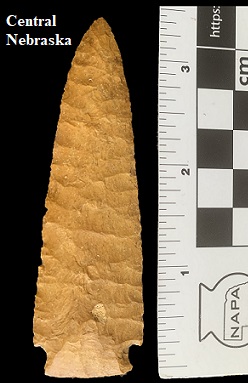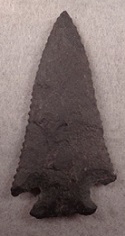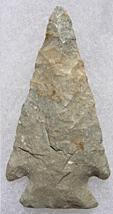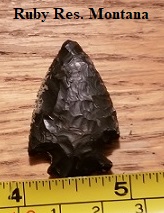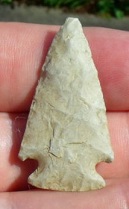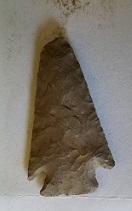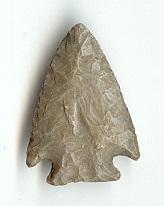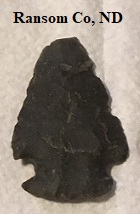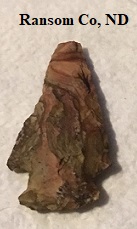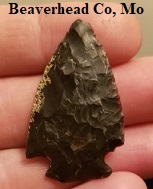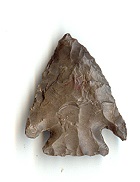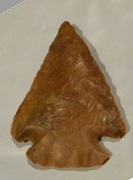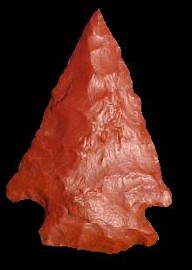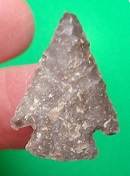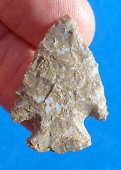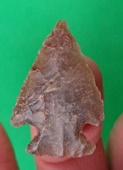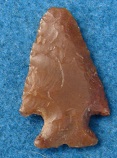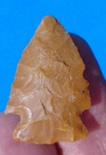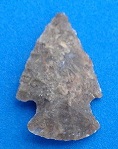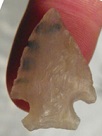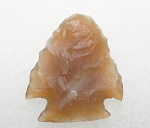Name Details:
Named By: Boyd Wettlaufer
Named For:
Associated Pelican Lake culture / phase
Date Identified: 1956
Type Site: Mortlach Site, near Moose Jaw
in Besant Valley, Saskatchewan
Pelican Lake
Cluster: Plains Large Corner Notch Cluster
Date:
Cultural Period:
3,500 -2,200 B.P.
Late Archaic
Neoglacial to Roman Warm
Sub Atlantic Period
Pelican Lake Culture
Glacial Period:
Culture:
Outline is Representative of Size and Shape:
Description of Physical Characteristics and Flaking Pattern:
This is a
medium triangular corner notch point with a flattened to elliptical cross section. The blade
varies from straight to excurvate. Commonly the widest portion
of the point is at the shoulders. The shoulder are barbed with a
short, broad expanding stem. The base may range
from straight to concave with basal thinning and may exhibit light basal grinding. This point
is manufactured using random percussion flaking with pressure
flaking used to trim and retouch the blade forming a random flaking pattern,
Workmanship is dependent upon the quality of the material.
Size Measurements: Total Length
- 30 to 80 mm, Stem Length - 5 to 10 mm, Blade Width -
14 to 34 mm, Neck Width - 11 to 17 mm, Stem Width - 15
to 21 mm(Typically 2/3 the total length of the blade) Thickness - 4 to
7 mm
Distribution:
Distribution Comments:
These points are most commonly found from Alberta and Saskatchewan and into Montana, North Dakota, and Minnesota. They may be found into northern Wyoming,
Nebraska, and northern Iowa
with decreased frequency.
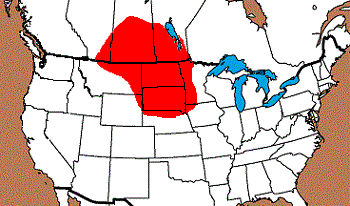
Additional Comments:
The oldest point in this cluster are the Pelican lake points from the Pelican Lake culture. These points overlap with the
Besant points, the oldest of the Besant culture. Samantha points followed (and may have continued for a period of time) the Besant point. (W2).
Pelican Lake type points with strong barbs would be typed as Larter Tanged type points.
Point Validity: Valid Type
Wettlaufer is a distinguished
anthropologist and is considered the “Father of Saskatchewan Archeology”. This type was named in a professional publication and has many professional references. This is considered a valid type.
.
Age Details:
The Pelican Lake complex and associated Pelican Lake point, was dated at
about 1 to 700 C.E. (Frison 1992:101–111; Foor 1998). This age was revised
to 1,800 B.C.E. to 350 C.E. by Dyck and Morlan (2001) Syms (1980:364–365)
separates corner notched points dating within circa 1500 B.C.E. to 400 C.E.
in southwestern Manitoba into larger, earlier “Archaic Barbed” points (1200
to 100 B.C.E.) and more recent, smaller corner notch which shallower notches
refereeing to them as “Plains Middle Woodland Pelican Lake” points (ca. 400
B.C.E. to 800 C.E.) (Morrow, 2016).
References: (See Reference Page, Entry Number):
8,
23, 30, 168, 176, 180, W11
Pelican Lake Projectile Point, Pelican Lake Arrowhead
